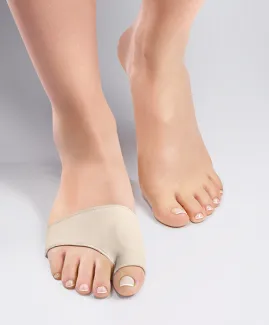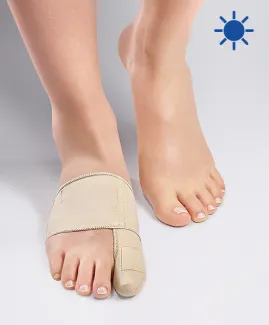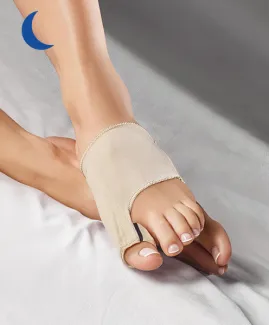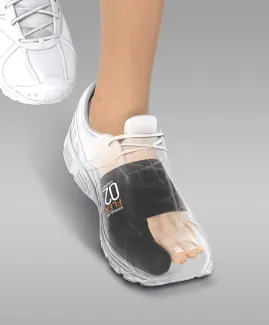
Why do people get bunions ? Are they genetic or anatomical causes for bunions on feet? Can men also get them?
What causes bunions has still not been clearly identified. But we know that some background elements can contribute to the deviation of the big toe. With little explanation about its origins, you may be able to prevent bunion pain or delay its onset. Focus on all the causes of bunions with EPITACT®, foot care specialist of hallux valgus!

Causes and risk factors of bunions
A bunion or hallux valgus is a common foot deformity in which the big toe points towards the other toes. Such a deformity can be present since birth or appear later in adulthood. Many factors contribute to its onset, either avoidable or unpreventable, for example:
- Genetic factors;
- Anatomical factors (foot shape, muscle imbalance…);
- Pathological factors ;
- Shoes;
- Gender;
- Weight;
- Age.
Now, let’s focus on each cause of bunions.
Genetic causes of bunions
There is a family history of hallux valgus in 63% to 90% of cases(1). Studies show that hallux valgus is a family matter, repeated from one generation to the next. The genetic risk factor for bunions could be an excessive flexibility of the joint (hyperlaxity), or too severe expansions of tendon attachment(2, 3). Extreme high joint flexibility combined with a deficit of muscle balance are supposed to facilitate the deviation of the metatarsus.
Foot shape
The shape of your feet is another important genetic background likely to cause a bunion. Three big categories can be distinguished:
- Greek foot shape: the second toe is longer than the big toe;
- Egyptian foot shape: the big toe is longer that the four lesser toes, whose length decreases from the second toe to the little toe;
- Square foot shape: the first toe (hallux) and the second toe have the same length.
People with Egyptian foot shape seem to have higher probability to develop bunions than those with Greek shape or square shape. As the first toe is longer than the others, it is more exposed to physiological stress, which increases its lever effect(4).
Anatomical causes of hallux valgus
It is not clear what causes bunions on feet but it seems that anatomical factors play an important role in the onset of hallux valgus.
- Flat feet contribute to foot pronation (off-centring outwards) and to axial rotation of the first metatarsal bone. Progressively, it increases the length of the first ray and the pronation of the big toe at the end of the walking movement.
- The orientation as well as the anatomy of articular surfaces between the first metatarsal and the first phalanx can cause anatomical deviations and cause a bunion.
- Another theory by Curvale and al.(5) explains that when all predispositions for hallux valgus are present, the first phalanx then operates like a pushing element. It would create inwards (varus) pressure on the metatarsal bone and finally accentuate the process. Though this may not be the main reason, this adds to the other causes of bunions.
- Local muscle increase could be another cause of hallux valgus. The abductor hallucis muscle is the only one providing opposition to the metatarsus varus (inwards). The more the deformity progresses, the more the tendon of the abductor hallucis slips along the medial side of the first metatarsal head until it settles in this position. The deviation can then continue without any physical opposition as the abductor follows the modification of the tendon under the metatarsal head.
Shoes are major causes of bunions on feet
Inappropriate footwear seems to be a major risk factor. For example, avoid regular wear of:
- high heels (over 5cm);
- chisel toe boots;
- pointy shoes;
- narrow and tight footwear.
They compress the big toe which has no other choice but to adapt to the shape of the shoe and high heels transfer the weight of the body to the forefoot. As a result, it increases stress on the metatarsals, toes and joints. As well as causing joint pain, these kinds of shoes put pressure and rub against the bunion which becomes very painful when walking.
Wearing poorly fitting shoes is a risk factor for the onset or recurrence of bunions. Try to change your habits and choose shoes that fit you well!
Diseases that increase the risk of having a bunion
Bunions can also be due to rheumatic or neuromuscular diseases, for example(6).
The causes of bunions on feet include the gender and weight
Doctors don't know exactly what causes bunions, however, there are some suspected causes related to gender and weight. Indeed, women have an increased likelihood of bunions compared with men. Hallux valgus is said to affect women in 90 to 95% of cases(7)!
The studies by Nguyen and al.(8) on 600 patients in the USA point out that the bunion causes are different regarding men and women. It seems that wearing uncomfortable footwear combined with a low Body Mass Index (BMI) are determining factors in the development of a bunion in women. On the contrary, high BMI and flat feet are risk factors for bunions in men.
However, it would be interesting to place this theory in confrontation with the fact that mostly women develop a bunion on their feet, and this probability increases with age(9).
Age is often correlated with hallux valgus
Prevalence of bunions increases with age: in 90% of cases, the deformity begins between 40 and 50 years of age(1). In the general population, a meta-analysis evaluated the prevalence of hallux valgus to 8% in children, 23% in the 18-65 age group and 36% in persons over 65(5).
There is a solution to each bunion
Every person, every foot and every bunion are different. To make sure you find the right solution, EPITACT® has specialised in the creation of bunion protections and braces. This irreversible deformity cannot disappear over time; surgery is the only definitive treatment. However, it is possible to relieve pain and delay surgery.
If you have a mild or moderate hallux valgus, EPITACT® recommends the flexible* or the rigid bunion corrector*. These complementary devices straighten the big toe and relieve joint pain day and night.
For people with bunions at an advanced stage, the EPITACT®bunion protector* relieve pain caused by pressure and rubbing against the shoe. This reusable and comfortable solution is ultrathin and fits all your shoes.
You just have learned what causes bunions on feet. Note that they rarely have one single factor. It is clear that you can’t choose your genetic and anatomical background, however, choosing appropriate shoes belongs to you.
It is crucial to know what are the risk factors of bunions before the bump appears on your foot. This allows people who get bunions or those at risk of developing one to understand the different ways of limiting the progression of symptoms. For more indications about the shoes appropriate when having a bunion, click here.
*These solutions are class I medical devices that bear the CE marking under this regulation. Carefully read the instructions before use. Manufacturer: Millet Innovation. 04/2023
For more details about this general and simplified approach, here are further sources:
(1)Hannan MT, Menz HB, Jordan JM, Cupples LA, Cheng C-H, Hsu Y-H. High Heritability of Hallux Valgus and Lesser Toe Deformities in Adult Men and Women: Heritability of Hallux Valgus and Toe Deformities in Adults. Arthritis Care & Research. sept 2013; 65(9):1515‑21.
(2)Al-Saggaf S. Variations in the insertion of the extensor hallucis longus muscle. Folia Morphol (Warsz) 2003; 62:147–55.
(3)Gunal I, Sahinoglu K, Bergman RA. Anomalous tibialis posterior muscle as an etiologic factor in hallux valgus . Clin Anat 1994;7:21–5.
(4)Lelièvre J., Pathologie du pied. Paris : Masson, 1961
(5)Curvale G, Rocheweger A, Piclet-Legre B. Hallux valgus . Podologie. 1999; 27-080-A-30: p 6.
(6)Nix SE, Vicenzino BT, Collins NJ, Smith MD. Characteristics of foot structure and footwear associated with hallux valgus: a systematic review. Osteoarthritis and Cartilage. 1 oct 2012;20(10):1059‑74.
(7)Ameli.fr. Hallux valgus (oignon au pied) : symptômes, causes et évolution [Internet]. L’Assurance Maladie. 2021 [cité 26 sept 2022]. Available at: https://www.ameli.fr/assure/sante/themes/hallux-valgus/symptomes-causes-evolution
(8)Nguyen U-SDT, Hillstrom HJ, Li W, Dufour AB, Kiel DP, Procter-Gray E, et al. Factors associated with hallux valgus in a population-based study of older women and men: the MOBILIZE Boston Study. Osteoarthritis and Cartilage. janv 2010; 18(1):416.
(9)Nix S, Smith M, Vicenzino B. Prevalence of hallux valgus in the general population: a systematic review and meta-analysis. J Foot Ankle Res. déc 2010; 3(1):21.
 Pharmacie
Pharmacie


